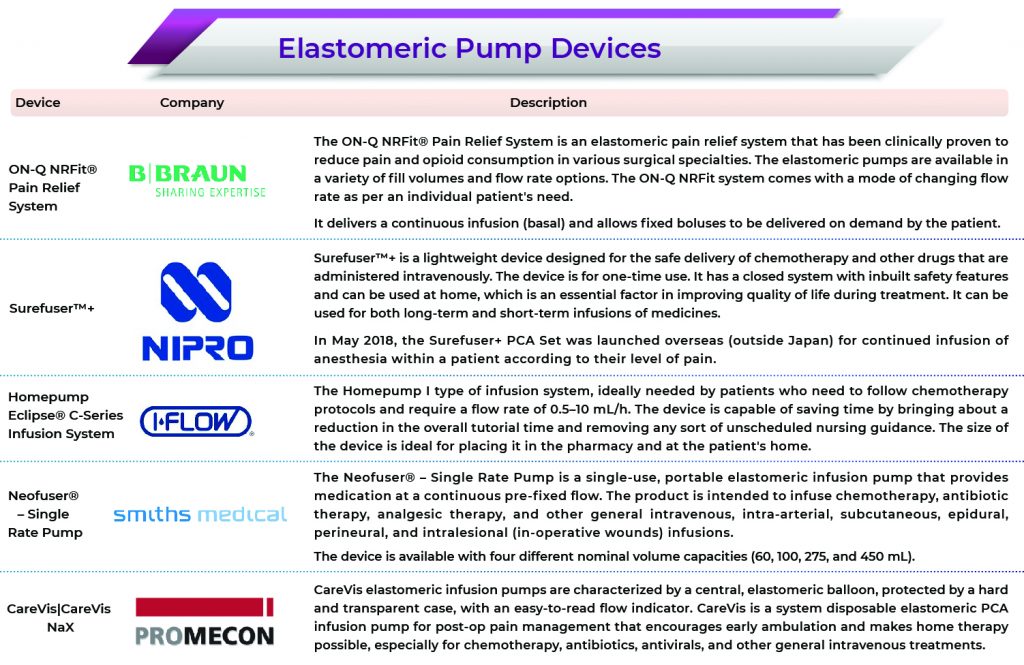Which Companies are Vying to get a Major Chunk in the Elastomeric Pump Market?
May 28, 2021
Table of Contents
An infusion pump is a medical device that is employed in the administration of fluids such as nutrients and medications into a patient’s body in controlled amounts. Infusion pumps are extensively used in clinical settings such as hospitals, nursing homes, and homes. There are many types of infusion pumps, including large volume, patient-controlled analgesia (PCA), insulin, elastomeric, syringe, enteral, and pumps.
An Elastomeric Pump is a type of infusion pump referred to as a ball pump or a balloon pump. It is a medical device used for infusing medication. Depending on the required therapy, these medications may include antibiotics, chemotherapy, analgesics, and local anesthetics.
Downloads
Article in PDF
Recent Articles
- Asahi Intecc Partners with Penumbra; Prosoma and EVERSANA Announce Commercialisation Partnership;...
- BioGX’s ‘pixl’ Portable qPCR Platform; Stryker’s Citrefix Suture Anchor System; Boston Scientific...
- Medtronic Announced World’s First Approval for MiniMed 780G System; CE Mark for Medtronic’s...
- STRATA Skin Sciences’ XTRAC Momentum™ 1.0 Device Approved in Japan; eCential Robotics Received FD...
- Vivos Therapeutics Receives FDA 510(k) Clearance for Pediatric Sleep Apnea; Nevro Launches AI-Dri...
The medication is infused by the pressure created by an elastomeric layer which is molded inside the pump. The elastomeric layer becomes stretched, and the elastic constriction then drives the liquid present through the tubing when the elastomeric pump gets filled.
The liquid eventually goes through the flow restrictor and is administered to the patient via the central venous catheter. The pressure will be consistent in level until the infusion is nearly over, which is usually a pressure spike that results in a slightly higher flow rate.
A wide range of elastomeric infusion pumps is now available from different manufacturers. They are calibrated in different conditions, including operating temperature and pressure, a viscosity of fluid, backpressure, and time recommended between filling the device and the beginning of the infusion.
Mechanism of an Elastomeric Pump
An elastomeric infusion pump includes a monolayer or multilayer elastomeric membrane, an outer protective shell, the administration tube set, and a flow restrictor system. The stretched elastomeric membrane contains the fluid and generates the pressure required for the delivery of medication.
The key parameters that influence the pressure generated on the fluid in a stretched balloon consist of the type of elastomer, the number of elastomeric layers, and the reservoir balloon geometry. The flow restrictor system mechanically limits the delivery rate to the set values. Elastomeric pumps can generate a driving pressure of 260–520 mmHg and infuse at rates of 0.5–500 mL/h.
Elastomeric pumps work on pressure to infuse the medication. The pressure is introduced by an elastomeric layer which is molded on the inner side of the pump. The filling of the Elastomeric pump results in the stretching of the elastomeric layer. The resultant elastic constriction causes the liquid/therapeutic drug to move through the tubing and passing through the flow restrictor, which is administered to the patient through the connecter. The pressure level is consistently maintained until the end of the infusion, when a pressure spike is introduced, resulting in a slightly higher flow rate.
The flow restrictor controls the accuracy of the rate of flow. It is typically a glass capillary or a steel cannula that is molded into the system tubing or, at times, maybe placed inside the elastomeric reservoir. The placement of an elastomeric pump affects the flow rate of the therapeutic drug due to the head height effect.
Elastomeric Pump: Types of Pump
Continuous Rate Elastomeric Infusion Pumps
These pumps allow the continuous administration of the therapeutic drug after the initial setup, resulting in a steady concentration plateau. These pumps are used to infuse chemotherapy drugs, antibiotics, and continuous administration of elastomeric energy drugs. These are suitable for hospital application, home care therapy, and situations where a continuous infusion of drugs is required.
Variable Rate Elastomeric Infusion Pumps
Variable-rate Elastomeric Pumps allow a more customizable approach in adjusting different flow rates varying from 100 to 300 mL of capacity. These pumps are equipped with rigid reservoirs that have graduations on them. These variable rate pumps can also be used for various treatments such as pain management, chelation therapy, and others.
As per the DelveInsight’s Elastomeric Pumps market analysis, in terms of market share by product type, it has been seen that the continuous rate flow pumps are being majorly used, accounting for approximately 81%.
Elastomeric Pump Device: Application
Elastomeric Pump finds its application in various forms of drug delivery depending on the requirement, including antibiotics, chemotherapy, analgesics, and local anesthetics. The various fields of application include:-
Postoperative analgesia via continuous perineural infusion of local anesthetics compares favorably with systemic analgesia. Elastomeric pumps increase patient satisfaction compared with electronic models. These devices are used to administer analgesics in events after surgeries to treat orthopaedic-related ailments and amputation surgeries. They help in maintaining drugs plasma level and analgesia to control acute pain and improve patient’s quality of life, which are effective alternatives for treating pain
Ambulatory chemotherapy allows the delivery of short and extended chemotherapy infusions through a portable pump from the comfort of patients’ homes. It is essential to offer it for suitable candidates to ensure both their safety and the success of the treatment session. This requires a delicate balance between clinical assessment and patient acceptance. They have enabled cancer patients to adhere to their treatment regimen without compromising their daily schedule.
Outpatient parenteral antibiotic therapy (OPAT) is a growing area of practice that has numerous benefits for both patients and the healthcare system. The use of Elastomeric Pumps to deliver intravenous (IV) antibiotics can have many benefits for OPAT services as they are cost-effective, easy to use, and allow the patient to be fully ambulant, thereby streamlining the process of patient care and compliance with the treatment.
Elastomeric Pump: Advantages
- Boast of simpler design making them easy to operate and free from programming errors
- Lightweight and small size enabling patients to adhere to medication regimen
- Cost-effective, thereby making them accessible to a larger population
- Help in the maintenance of drugs plasma level stability
- Improves quality of life of patients
- Independence from an external power supply
- Patients’ preference towards Elastomeric devices to electronic pumps
Elastomeric Pump: Disadvantages
- Possibility of inaccurate flow rates
- Inability to trace the history of the administered drug demand by the patient
- Fixed reservoir volume
- Detection of abnormal drug delivery is difficult due to the absence of alarms
Elastomeric Pump Market Dynamics
The Elastomeric Pump market is estimated to increase due to advancements in healthcare technology, high healthcare expenditure, and available reimbursement policies in developed countries.
Elastomeric Pumps have a simplistic design compared to their counterparts, such as electronic infusion pumps. These pumps do not require gravity or electricity in any form for their operation, thereby aiding in their easy operability. As these devices are lightweight and small in size, they are preferred by patients for being portable, and the easy device set up, making them popular among the older population.
As per the Centers for Disease Control and Prevention, each year, about 650,000 cancer patients receive chemotherapy in an outpatient oncology clinic in the United States. This increasing number of patients needing chemotherapy and analgesics are increasing the market demand for Elastomeric Pump around the world.
Along with this, the growing geriatric population globally and technological advancements are factors responsible for the growth of Elastomeric Pump devices.
However, the availability of alternatives for medical devices, problem in the accurate rate of drug delivery, product recalls can deter the market’s growth in the coming years.
COVID-19 has positively impacted the market in 2020 because infusion pumps were positioned as one of the essential devices for drug delivery. The market saw high year-on-year growth in 2020 as compared to previous years.

Elastomeric Pump Market Players
As per DelveInsight analysis, the market for Elastomeric Pump consists of many leading companies. Apart from the leading player, the market consists of many local players too, especially in Europe. There are around 25 major companies for Elastomeric Pump active in 7MM.
The companies operating in the Elastomeric Pump market include B. Braun Medical Inc., Baxter International Inc., Daiken Medical Co., Ltd, Nipro Corporation, Halyard Health, Inc., Heka s.r.l, Leventon S.A.U., Avanos Medical, Smiths Medical Inc. (Smiths Group).

Elastomeric Pump: Developmental Activities
- In November 2020, Ambu Inc. entered into a new agreement with Intalere for pain care management solutions. As per the agreement, Intalere members would receive negotiated pricing on the Ambu® ACTionTM Block Pain Pump. The advanced technology of the non-electric ACTion Block CPNB Pump produces flow consistencies common to electrical pumps. This contract would be effective by October 31, 2023.
- In May 2018, the Surefuser+ PCA Set was launched overseas (outside Japan) for continued infusion of anesthesia within a patient according to their level of pain.
- DOSI-FUSER Elastomeric Pumps were recalled from the US market as the product lacked 510(k) clearance and was misbranded. However, on June 08, 2020, the FDA terminated the recall status.
Market Forecast
Being cost-effective, Elastomeric pumps have been adopted enthusiastically by patients. Moreover, considering their versatile usage, they are employed in drug administration for different purposes. This has also resulted in their coverage under various reimbursement programs. This is expected to drive the Elastomeric Pumps market.
The growth of the Elastomeric Pumps market in the coming years will be hindered because of the factors such as lack of awareness regarding usage of Elastomeric Pumps, recall of products, adverse events reports, and alternative options available like smart pumps.
Technological advancements hold a major potential in improving the product design so that the simplistic design of Elastomeric Pumps can be amalgamated with the new-age tech features to cater to a wider population base in the coming years.
Downloads
Article in PDF
Recent Articles
- Interoperability Solutions in Healthcare – Evolving Market Dynamics and Improving Health Ou...
- With advancements in Innovative Technology, Cardiac Monitoring Devices Market is Booming Signific...
- Philips Teamed with SyntheticMR; BioPhotas’s Celluma Light Therapy; Boston Scientific’s AGE...
- How Are Innovations in Drug Delivery Devices Solving the Complex Challenges in the Market?
- FemTech Market: With 100+ Startups in the domain, Women Healthcare is Witnessing a Huge Upliftment



